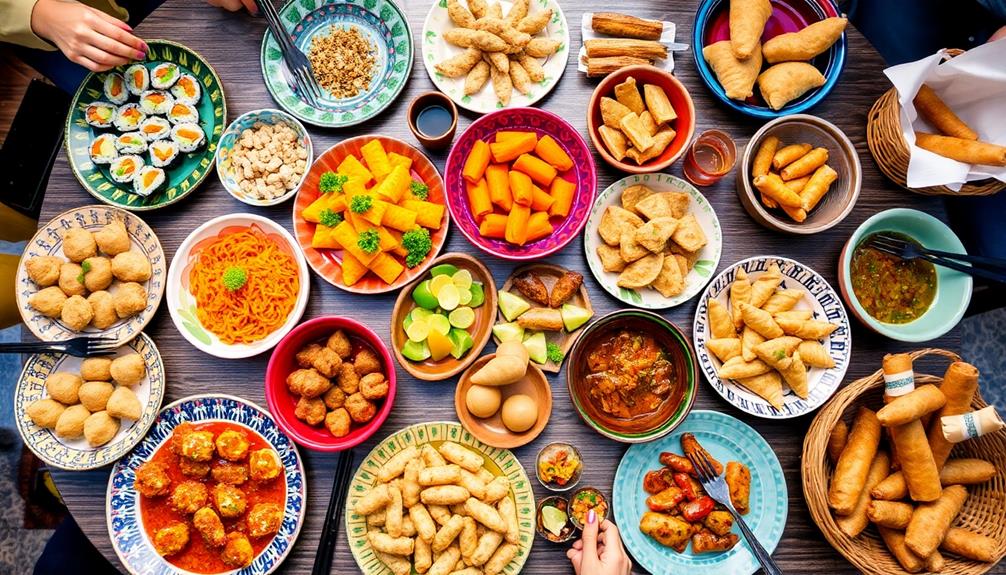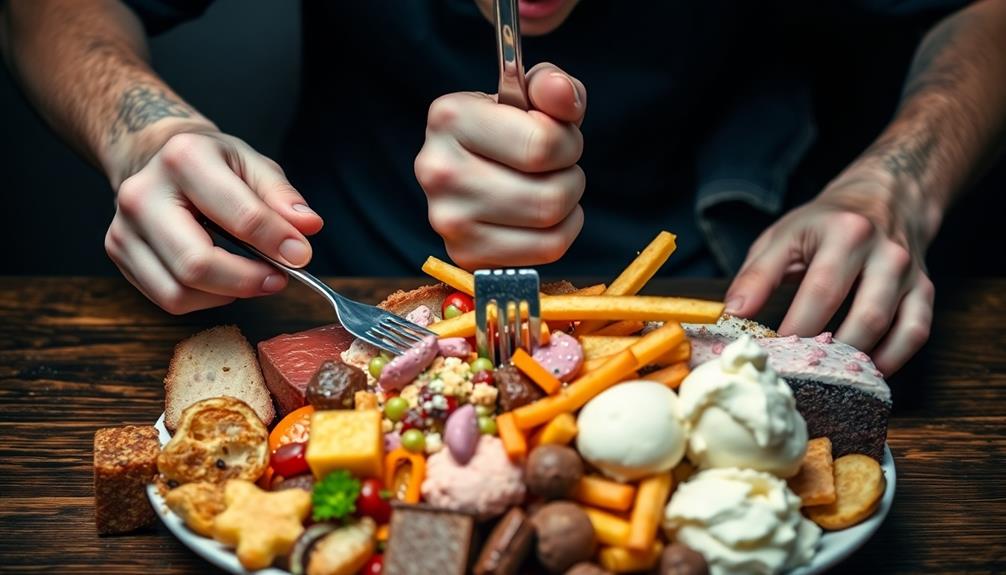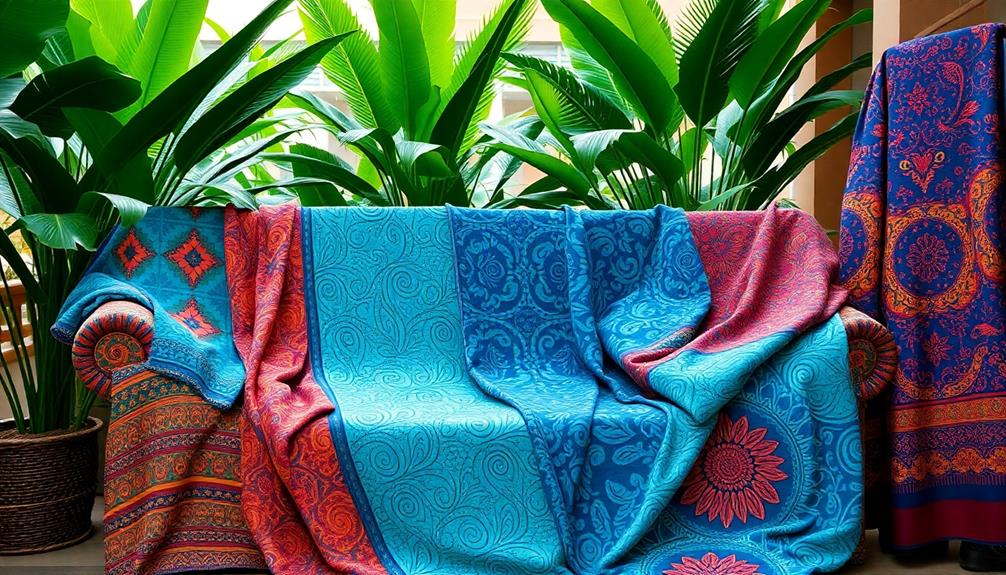Different cultures approach snacking in unique ways that reflect their traditions and preferences. In France, you might find casual, flavorful options enjoyed outside regular meals. Australians and Americans consume a significant portion of their daily energy from snacks. In Brazil, vibrant street foods illustrate a rich culinary heritage, while Latin American snacks often mix sweet and savory elements. Today, many people seek healthier, less processed snacks, influenced by modern trends and social media. This diversity in snacking adds richness to global diets, and you're sure to discover even more intriguing insights about these practices as you explore further.
Key Takeaways
- Snacking practices vary globally, with France favoring casual snacks outside meal times, while Brazil showcases diverse street food options reflecting culinary heritage.
- In Australia and the U.S., snacks constitute a significant portion of daily energy intake, highlighting their importance in local diets.
- Cultural backgrounds influence snack choices, with Hispanic and Asian communities embracing traditional flavors and innovative products from recent immigrants.
- Health perceptions of snacks differ; while some countries associate them with junk food, there's a growing shift towards healthier, natural options among consumers.
- Social media plays a crucial role in shaping snacking habits, promoting visually appealing and creative snack experiences across cultures.
Snacking Traditions Around the World
Snacking traditions vary widely across the globe, with each culture bringing its own unique flavors and practices to the table. In France, snacking often happens outside traditional meal times, lacking the cultural significance seen in formal meals.
Australians and Americans, on the other hand, have a high prevalence of snacking, with snacks accounting for 33% and 25% of their daily energy intake, respectively. In Brazil, street vendors often offer a variety of snacks that reflect the nation's diverse culinary heritage, such as traditional Brazilian sweets that highlight the use of ingredients like coconut and peanuts.
In many Latin American countries like Mexico, snacking is common, often featuring sweetened beverages and savory snacks, contributing about 15% to total energy intake.
Asian cultures, particularly in China, lean towards healthier snack choices, with fruits and milk being popular among children. These habits reflect a growing awareness of nutritional quality, as these snacks contribute 10% of daily energy intake.
Across the globe, there's a notable shift in the snack market, where consumers increasingly prefer healthier snack options, favoring minimally processed foods that offer nutritional benefits. This trend highlights the evolving food choices and eating habits, emphasizing the importance of global flavors while promoting healthier diets.
Cultural Influences on Snack Choices
As cultural backgrounds shape individual preferences, snack choices often reflect heritage and traditional flavors. For many, food isn't just sustenance; it's a bridge to their roots.
Take Hispanic and Asian communities, for example—they frequently gravitate toward snacks that celebrate their cultural influences, such as the savory and rich flavors found in Red-Braised Pork Belly. You might notice that nearly 50% of Gen Z in the U.S. identifies as a race or ethnicity other than White, highlighting a growing diversity that enriches snacking habits.
Recent immigrants often blend traditional flavors with modern practices, leading to innovative products that cater to evolving tastes while promoting healthier dietary intake. Snacks become a vehicle for cultural expression, allowing brands like Saffron Road and Brazi Bites to resonate with consumers seeking authenticity.
This shift towards global flavors opens up exciting opportunities for food brands. They can innovate and adapt to diverse interests while ensuring they maintain an accurate representation of different cultures.
As you explore the snack aisles, consider how much cultural influences shape the foods you enjoy, connecting you to a rich tapestry of flavors and traditions that reflect the world's diversity.
Health Perceptions and Snacking
When it comes to health perceptions, snacks often carry a mixed reputation. In some cultures, like France, snacking is linked to junk foods and unbalanced diets, which can deter you from casual eating between meals.
On the flip side, adolescents are increasingly seeking healthier options, with foods like cereal bars gaining popularity over traditional sweets. This shift reflects changing health perceptions and a desire for better dietary health. Furthermore, in Indian cuisine, snacks like Mushroom Masala offer flavorful and nutritious options that can easily fit into a balanced diet.
The nutritional quality of your snacks plays an essential role in your overall energy intake. For instance, studies show that Australian children derive about 33% of their total energy from snacks, while in China, that figure is just 10%. These differences highlight varying cultural attitudes towards snacking occasions.
As consumer trends evolve, especially among younger demographics, there's a growing demand for snacks made with natural ingredients and minimal processing.
You're likely to see this reflected in the market, where healthier options are becoming the norm. By being mindful of the snacks you choose, you can contribute positively to your dietary health while enjoying the convenience of snacking.
Impact of Modern Trends
The rise of modern trends is reshaping how you think about food, with snacking emerging as a primary eating pattern that now accounts for 50% of all food and beverage occasions worldwide.
These significant changes reflect a shift in food culture, where traditional food is often sidelined for more innovative snack options, such as Halloween-themed snacks that engage creativity and festivity.
You're likely noticing that consumers prefer fresh, less processed snacks, aligning with a health-conscious mindset prioritizing nutrition and ingredient transparency.
In this evolving landscape, the demand for snacks that offer sustained energy has led to a focus on functional benefits like protein and fiber.
Social media also plays a crucial role in shaping snacking patterns, making leisure activities around food more visually appealing and social.
Trends like charcuterie boards encourage you to view snacking as a shared experience rather than a solitary one.
Moreover, the growing interest in global flavors and flexible snack formats caters to diverse dietary preferences, enhancing the consumer and market appeal.
As you navigate these modern trends, it's clear that snacking is no longer just about convenience; it's become an essential part of your eating occasions and lifestyle.
Future of Snacking Practices
Consumers increasingly embrace innovative snacking practices that cater to their busy lifestyles and evolving tastes. As the global snack market is set to exceed $500 billion by 2026, you're likely to see a wide variety of options that blend snacks and meals seamlessly. This trend reflects your need for convenient, nutritious choices that provide energy throughout the day. For instance, dishes like Nettle and Potato Soup showcase how fresh, seasonal ingredients can enhance snack-like offerings.
With an increasing focus on health, you might notice more organic, natural, and minimally processed snacks. Dietary habits are shifting, and brands are responding by offering gluten-free, vegan, and allergen-friendly snacks. These options not only satisfy your cravings but also cater to specific dietary needs, showcasing the significant part snacks play in modern daily life.
Sustainability is also becoming vital in your food and beverage choices. Brands are adopting eco-friendly packaging and prioritizing transparency in their supply chains, aligning with your preferences for responsible consumption.
Social media continues to influence food trends, encouraging creativity in snacking. As you navigate these changing practices, you'll better understand how snacking evolves and the role it plays in your life, making it an exciting time for snack enthusiasts everywhere.
Frequently Asked Questions
How Does Culture Influence Eating Habits?
Culture influences your eating habits by shaping your preferences, traditions, and food choices. It guides what flavors you enjoy, when you eat, and even how you share meals, creating a unique culinary identity for you.
What Is the Snack Culture?
Snack culture's vibrant and diverse, reflecting preferences for convenience and health. You'll find people enjoying quick bites during busy days, seeking flavorful, organic choices that cater to their tastes and lifestyles, making snacking a universal delight.
What Is the Concept of Snacking?
Imagine wandering through your day, feeling peckish. Snacking's the act of grabbing bites between meals, offering convenience and satisfaction. It fills gaps, satisfies cravings, and can reflect both your lifestyle and nutritional choices.
How Does Food Connect People From Different Cultures?
Food connects you to diverse cultures through shared meals, traditional recipes, and communal gatherings. When you explore different cuisines, you foster understanding, create memories, and build relationships, enriching your appreciation for global culinary heritage.
Conclusion
As you explore the rich tapestry of snacking traditions worldwide, you might wonder if these practices really matter in today's fast-paced society. They absolutely do! Understanding how different cultures approach snacking not only enriches your culinary experience but also highlights the importance of shared moments and health perceptions. Embracing diverse snack choices can lead to healthier habits and deeper connections. So, why not savor a taste of the world the next time you're reaching for a snack?









